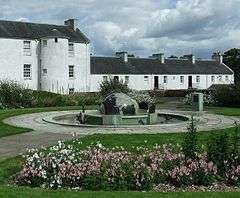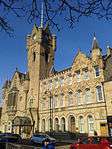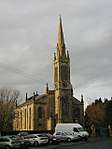Blantyre, South Lanarkshire
Blantyre
| |
|---|---|
 Shuttle Row, the birthplace of David Livingstone | |
 Blantyre Blantyre shown within South Lanarkshire | |
| Population | 17,505 (2001) |
| OS grid reference | NS685575 |
| Civil parish |
|
| Council area | |
| Lieutenancy area | |
| Country | Scotland |
| Sovereign state | United Kingdom |
| Post town | Glasgow [1] |
| Postcode district | G72 |
| Dialling code | 01698 |
| Police | Scottish |
| Fire | Scottish |
| Ambulance | Scottish |
| EU Parliament | Scotland |
| UK Parliament | |
| Scottish Parliament | |
Blantyre (![]()
![]()
Blantyre was the birthplace of David Livingstone, the 19th-century explorer and missionary (see below).
Blantyre has a number of small hamlets. High Blantyre is the area to the east and south of Burnbrae Road and continues to High Blantyre cross at the north. It is thought to be the area of earliest settlement, with a Bronze Age village near Auchintibber 2 miles (3 km) south of Blantyre Parish Church (High Blantyre). Also to the west is Greenhall Park, where the Calder (Cawther) flows to eventually join the Clyde near Newton.
Blantyre is loosely divided in half by Main Street, High Blantyre. At the west-end is Priory Bridge – named after the former priory to the north which was home to monks from around 1235. There is also Coatshill and the village, the oldest industrially developed part of Blantyre. Glasgow Road continues south via Springwell and eventually joins to Burnbank. Next to the David Livingstone museum, at the end of Station Road, is an iron suspension footbridge which crosses the River Clyde giving pedestrian access to Bothwell.[4]
Mine disaster
On 22 October 1877, Blantyre was the site of the Blantyre mining disaster, where 207 miners (men and boys) were killed when a coal mine exploded due to methane gas. A monument to the disaster of which the youngest victim was a boy of 11 is at High Blantyre cross. The site of the mine now lies under the East Kilbride expressway.[5]
Nearby towns and cities
- Hamilton (borders the Burnbank, Hillhouse and Whitehill areas)
- Glasgow (City Centre) 8 miles (13 km)
- Bothwell 2 miles (3 km)
- Uddingston 3 miles (5 km)
- Cambuslang 2.5 miles (4.0 km)
- Rutherglen 5 miles (8 km)
- East Kilbride 4 miles (6 km)
- Motherwell 5 miles (8 km)
Sport
Football
Blantyre presently has a football club competing in Scottish Junior Football Association competitions, Blantyre Victoria. Known as the Vics, they won the Scottish Junior Cup (the highest achievement in junior football) in 1950, 1970 and 1982; their home ground is called Castle Park.[6] There is another football club in the town, Blantyre Celtic. The original club went out of existence in the early 1990s however, in 2010, they reformed as an amateur team.
Speedway
The town of Blantyre has long had links with speedway racing. In the pioneer days a group of riders who appeared at White City in Glasgow were known as "The Blantyre Crowd". They operated their own track at Airbles Road in Motherwell in 1930 and this was known as Paragon Speedway. The Blantyre Crowd also operated a more professional version on the same site in 1932. Speedway was staged at the Greyhound Stadium as the home of the Glasgow Tigers in the late 1970s/early 1980s before the new road forced a move to Craighead Park which closed down at the end of the 1986 season.
Skateboarding
Recently, Blantyre Skate Park has received a lot of business as the youth company Radworx has been operating within it as well as some other skate parks. The skate park contains a 4 ft (1.2 m) spine section as well as an 8 ft (2.4 m) halfpipe, alongside a 6 ft (1.8 m) counterpart. There is a 2 ft (0.6 m) mini-bowl and a credible street section which contains two fun boxes as well as a 5-set.
Redlees Park
During World War II, an Anti-aircraft battery and associated camp for military personnel known as the 'Whins' or 'Blantyreferme' was set up on open land off the Blantyre Farm Road between Newton and Blantyre;[7] the camp was used as emergency accommodation after the conflict, but the huts were later demolished. However, some of the AA battery buildings survived into the 21st century (albeit heavily vandalissed in some cases)[8] and were incorporated – along with a former clay quarry nearby – into the landscape of Redlees Urban Park developed by the local council.[9]
Schools
- Primary schools
- St. Blane's
- St. Joseph's
- High Blantyre Primary
- David Livingstone Primary
- Auchinraith Primary
- High school
Institutions
Blantyre contains many amenities, including:
- Blantyre Leisure Centre – sports centre with swimming pool
- Blantyre Asda
- Stonefield Park – with a purpose-built skate-park
- Victoria Nursing Home (for the elderly)
- David Livingstone Centre – museum built in the birthplace and former home of David Livingstone
- Six churches
- David Dale House – South Lanarkshire Council facility named after another famous Lanarkshire dweller, famous for his connection with New Lanark
- Blantyre Credit Union[10]
- Terminal One – Fully equipped Youth Centre with state of the Art Multimedia equipment, Recording Studio and Rehearsal Room, Community Internet Cafe, Mobile youth facilities including 3 x DIGIBUS's and mobile climbing wall and lots more.[11]
Youth
In August 1983, a democratic non party political pressure group was formed in Blantyre called Blantyre Youth Council, which aimed to represent young people's views in the town and actively engage young people in campaigning for better facilities. The youth council contributed over the next few years to developing youth involvement in the local volunteer centre and community council. BYC set up a youth enquiry service for young people and a Claimants Union which advised young people and adults. The youth council conducted a series of public meetings for youth throughout the town and conducted a survey amongst the town's youth which demonstrated a need for more and cheaper facilities for young people. The full-time Youth Enquiry Service Base was in the Elizabeth Scott Centre (now Terminal One). In 1984, as part of their "Working with young People"[12] policy, Strathclyde Regional Council created Blantyre Youth Development Team against initial opposition from Blantyre Youth Council who saw no need for an officer/adult led organisation in a town with an active and successful youth council. Blantyre Youth Council eventually agreed to disband however and support the youth development team on the principle that it was to be youth led. At an early meeting, the youth development team unanimously agreed to support a motion calling for the organisation to concentrate its energies on creating a youth centre in the town. The YDT gained charity status in 1997 and created the Terminal One youth centre.[11] It provides services to the young people of Blantyre and North Hamilton including music tuition, multimedia artistic tuition, recording studios, youth clubs, excursions and self-development programmes. It is funded by South Lanarkshire Council, the Scottish Arts Council and the Blantyre/North Hamilton SIP.
David Livingstone
Blantyre's most famous son is the 19th century missionary and explorer David Livingstone. He is acknowledged as the first European to see the "Mosi-oa-Tunya" (Tokaleya and Tonga: "the Smoke that Thunders") which he named in English Victoria Falls after then British sovereign Queen Victoria.
His birthplace and childhood home is now a museum at the end of Station Road, on the banks of the River Clyde. The Centre includes a museum dating from 1929 (now run by the National Trust for Scotland), a playpark, a cafe, a shop, an African Garden and several workshop studios.[13] An adventure assault course also existed there before a young man died in 1995. A pedestrian footbridge over the River Clyde adjacent to the museum (its third incarnation) links the area to the town of Bothwell.[4]
Mandala (the largest city and commercial centre of Malawi, one of the territories Livingstone explored) is more commonly named Blantyre in recognition of the link created by Livingstone during the colonial era.[14][15]
Notable natives or residents
- John Brown, footballer (Rangers)
- Martin Bulloch, drummer (Mogwai)
- Stuart Christie, anarchist
- Brian Connolly, musician
- John Cooney, Leinster rugby union player
- John Fallon, footballer (Celtic, Lisbon Lions)
- Ryan Fletcher, actor
- Ken McKinlay, speedway rider
- Jim Mullen (businessman), CEO Ladbrokes PLC
- Philip Murray, American trade union leader
- Maureen Rooney, trade unionist
- Steven Smith, footballer (Rangers, Portland Timbers, Aberdeen, Kilmarnock)
- Ian Stewart, former Labour MP for Eccles.
- William Bauchop Wilson, 1st United States Secretary of Labor
See also
References
- ↑ "List of UK post towns". Evox Facilities. Archived from the original on 2000-06-18. Retrieved 2012-02-22.
- ↑ "Usual Resident Population: Civil Parish: Blantyre". Scotland's Census Results Online: Census: 29 April 2001. General Register Office for Scotland, Edinburgh. 2011. Archived from the original on 22 March 2012. Retrieved 19 February 2011.
- ↑ Watson, W. (1926) A History of Celtic Place-names of Scotland". Edinburgh
- 1 2 "1999 David Livingstone Memorial Bridge". The Blantyre Project. Retrieved 9 August 2017.
- ↑ Information re mining disasters in Blantyre, blantyrepast.com; accessed 15 October 2016.
- ↑ "Blantyre Football". Archived from the original on 8 July 2008. Retrieved 15 October 2016.
- ↑ "AA Battery Blantyreferme". Secret Scotland. 1 April 2013. Retrieved 11 July 2018.
- ↑ "Uddingston, Blantyre Farm Road". Canmore. 20 June 2012. Retrieved 11 July 2018.
- ↑ "Redlees Quarry due for £300,000 makeover". Daily Record. 25 February 2010. Retrieved 11 July 2018.
- ↑ "Homepage". Blantyre Credit Union. Retrieved 17 March 2012.
- 1 2 "Terminal One".
- ↑ SRC 1984
- ↑ "Places to visit: David Livingstone Centre". National Trust for Scotland. Retrieved 9 August 2017.
- ↑ "Blantyre, Malawi". Lonely Planet. Retrieved 9 August 2017.
- ↑ "Blantyre, Malawi". Encyclopædia Britannica. Retrieved 9 August 2017.
External links
| Wikimedia Commons has media related to Blantyre, South Lanarkshire. |

